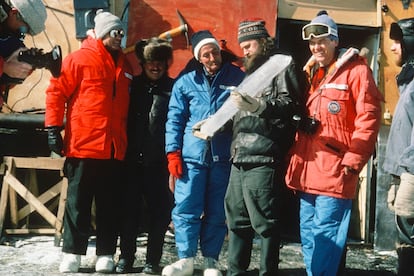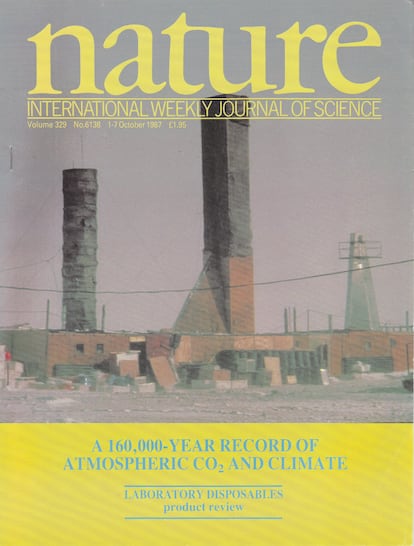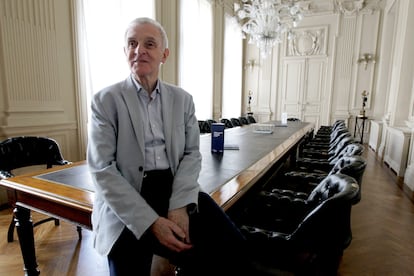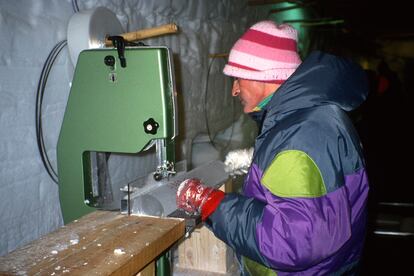The mission to the coldest place on Earth that changed the history of humanity
In the middle of the Cold War, a French expedition was able to access the Soviet Vostok base in Antarctica, where the temperature falls to -90ºC, to confirm the link between CO2 and global warming

It was one of the most epic scientific expeditions of all time. At the end of 1984, in the middle of the Cold War between the United States and the Soviet Union — two nuclear powers — an American C-130 plane landed in the inhospitable Russian base Vostok in Antarctica, located in the coldest place of Earth. A year earlier, a record low of -89.2ºC (-128ºF) had been registered at the base. The U.S. aircraft was carrying three French scientists — Claude Lorius, Michel Creseveur and Jean Robert Petit — on an extraordinary mission: collect ice from time immemorial to find out what the Earth’s remote past was like and predict the future of human beings.
Images from the time show that vodka was flowing, the accordion was playing and the red flag with the hammer and sickle of the Soviet Union was flying high in that hostile base. The Leningrad Mining Institute had chosen Vostok, near the geomagnetic south pole, as a testing ground for its new drilling technologies, in search of Antarctic oil. The base reeked of kerosene from the machinery, which had managed to make a hole more than 1.2 miles deep in the ice. Two decades earlier, in 1965, glaciologist Claude Lorius had a revelation while drinking whiskey with ancient ice at the French Antarctic base Dumont d’Urville. He looked at his glass and watched the bubbles emerging from the cubes. What if the trapped air contained information about the atmosphere and climate on Earth thousands of years ago? What if that data revealed the destiny of humanity?
Since that whiskey, Lorius had been determined to obtain virgin ice from the depths of Antarctica, so he convinced the Soviets to let him visit Vostok and convinced the Americans to transport him to the enemy base. The French glaciologist Jean Jouzel perfectly remembers the triumphant arrival of the Antarctic ice samples at his laboratory in Saclay, near Paris, in early 1985. It was a fragmented column measuring 2,083 meters, which at its oldest end was 160,000 years old. Jouzel never set foot on Vostok, but he analyzed its depths and amazed the world. The results of his research, published on the cover of the journal Nature on October 1, 1987, were definitive confirmation that the increase in carbon dioxide (CO₂) in the atmosphere caused global warming.

“It was a magnificent adventure, from a human point of view and also from a political point of view. We had meetings with Soviets and Americans, in the middle of the Cold War. The friendship between scientists was key to making that possible,” recalls Jouzel, sitting in a monumental room at the Palacio de San Nicolás, in Bilbao. On June 20, the 77-year-old glaciologist received the BBVA Foundation’s Frontiers of Knowledge Award — endowed with €400,000 ($432,000) — along with four younger colleagues who followed his path in Antarctica and Greenland, illuminating the origins of climate change.

The man who was inspired by the whiskey — Claude Lorius of the National Center for Scientific Research (CNRS) — died in March 2023 at the age of 91, but the Soviet colleague who opened the doors of Vostok to him is still alive: the legendary glaciologist Vladimir Mikhailovich Kotlyakov, from the Russian Academy of Sciences. Kotlyakov, 92, responded to EL PAÍS’ quesions in Russian, in emails written in Cyrillic alphabet. “The relations with French scientists over the years were very close and friendly. We didn’t feel any Cold War,” he says. Kotlyakov, a pioneer of Russian polar research, downplays the difficulty of surviving in the coldest place on Earth. “I visited Soviet bases in the interior of Antarctica and was outdoors in -70ºC [-94ºF], but I have to say that if you are properly wrapped up and also do physical exercise, such as digging a hole in the snow with a shovel, you can work even three hours,” he says.
Getting the ancient ice from Vostok to Jouzel’s laboratory was an epic journey. An American plane transported the samples from the heart of Antarctica to a Soviet ship, which took them to the French coast, where a refrigerated truck transported them to the Commissariat for Atomic Energy and Alternative Energies in the Paris region. Jouzel’s team immediately analyzed deuterium, a heavy form of the hydrogen that makes up the water molecule. The hotter it is, the more deuterium there is in the snow, with a mathematical proportion that allowed the temperatures of the last 160,000 years to be precisely calculated.

“Our discovery came at an extremely important time,” notes Jouzel. Another group of experts, led by U.S. meteorologist Jule Charney, had warned in 1979 that doubling the amount of carbon dioxide in the atmosphere would raise global temperatures by up to three degrees, according to simulations. Vostok’s data showed that this was not speculation. That 1.2-mile column of ice revealed how temperatures had changed over the last 160,000 years, from a low of nine degrees below the 198https://www.nature.com/articles/329403a07 average to a peak of two degrees above. The planet can warm naturally due to a subtle variation in its orbit around the Sun, but this phenomenon accelerates because, upon receiving more solar radiation, the oceans and soil release more CO₂ due to the decomposition of organic matter. Now, it is humanity that is fueling the greenhouse effect by burning oil, gas and coal. Just one year after the Nature cover, the United Nations General Assembly supported the creation of the Intergovernmental Panel on Climate Change (IPCC), says Jouzel.
The third vice president of the Spanish Government, Teresa Ribera, knows the French glaciologist well. They worked together between 2014 and 2018 at the Institute for Sustainable Development and International Relations, a Paris-based think tank. Jouzel was the president and Ribera, the director, until she returned to Spain to lead the Minister of Ecological Transition. “Paleoclimate, the study of the climate of the past, is fundamental to understanding the climate’s evolution. The contribution of Jean Jouzel and his colleagues in the 1980s was key to showing the correlation between climate and greenhouse gas concentration,” says Ribera. “Jouzel became a key reference in the first IPCC assessment report, which was decisive in achieving the first multilateral treaty to combat climate change adopted a few years later at the Earth Summit held in Rio de Janeiro in 1992.”

Vostok’s brave drillers did not stop at 2,083 meters. In January 1998, another hole reached 3,623 meters, a depth sufficient to confirm that CO₂ and methane in the atmosphere had been linked to temperature for 420,000 years. “I admire the Soviets. They continued drilling even in winter, with temperatures below -80ºC [-112ºF] They were formidable,” Jouzel recalls with a tone of nostalgia. In 1999, the French and Russian scientists published their new results in the journal Nature. The study included a warning to humanity: “Present-day atmospheric burdens of these two important greenhouse gases seem to have been unprecedented during the past 420,000 years.”
Jouzel remembers that Madrid hosted a crucial meeting of the IPCC between November 27 and 29, 1995. Delegates from oil-producing countries — such as Saudi Arabia and Kuwait — fought to water down every word of the expert group’s second report and to downplay the importance of human’s impact on the planet’s climate. “It was in Madrid where I proposed introducing the term climate surprise,” recalls the French glaciologist. Following their discoveries in the Vostok ice, Jouzel and his colleagues in Greenland had documented abrupt variations of up to 16 degrees in temperature in just a few decades, tens of thousands of years ago.

The latest IPCC report, published just over a year ago, warned that the burning of fossil fuels and the unsustainable use of energy and land has already led to global warming of 1.1ºC above pre-industrial levels. That increase has led to more extreme heatwaves, torrential rains, drought and megafires. “We are heading towards a 3ºC increase and, in some regions, it will be very difficult, if not impossible, to adapt. If we do not reduce emissions now, it is a terrible selfishness towards the youngest people,” warns Jouzel.
The weather has become unpredictable even in Vostok. On March 18, 2022, the thermometers at the Russian base recorded an unusual temperature of -17.7ºC, the highest in that month since records began in 1958. This is 15 degrees higher than the previous record, which was registered in 1967. It may be too soon to talk of climate surprise, but it is now clear that humans are warming the coldest corner of the planet.
Sign up for our weekly newsletter to get more English-language news coverage from EL PAÍS USA Edition
Tu suscripción se está usando en otro dispositivo
¿Quieres añadir otro usuario a tu suscripción?
Si continúas leyendo en este dispositivo, no se podrá leer en el otro.
FlechaTu suscripción se está usando en otro dispositivo y solo puedes acceder a EL PAÍS desde un dispositivo a la vez.
Si quieres compartir tu cuenta, cambia tu suscripción a la modalidad Premium, así podrás añadir otro usuario. Cada uno accederá con su propia cuenta de email, lo que os permitirá personalizar vuestra experiencia en EL PAÍS.
¿Tienes una suscripción de empresa? Accede aquí para contratar más cuentas.
En el caso de no saber quién está usando tu cuenta, te recomendamos cambiar tu contraseña aquí.
Si decides continuar compartiendo tu cuenta, este mensaje se mostrará en tu dispositivo y en el de la otra persona que está usando tu cuenta de forma indefinida, afectando a tu experiencia de lectura. Puedes consultar aquí los términos y condiciones de la suscripción digital.
More information
Archived In
Últimas noticias
Most viewed
- Sinaloa Cartel war is taking its toll on Los Chapitos
- Oona Chaplin: ‘I told James Cameron that I was living in a treehouse and starting a permaculture project with a friend’
- Reinhard Genzel, Nobel laureate in physics: ‘One-minute videos will never give you the truth’
- Why the price of coffee has skyrocketed: from Brazilian plantations to specialty coffee houses
- Silver prices are going crazy: This is what’s fueling the rally











































